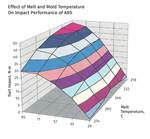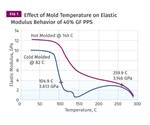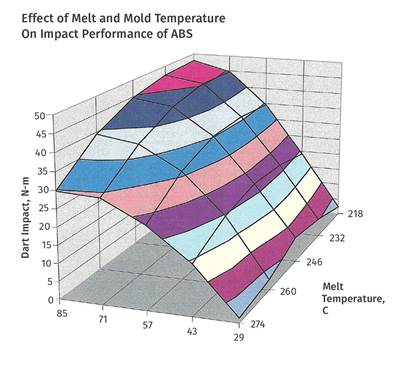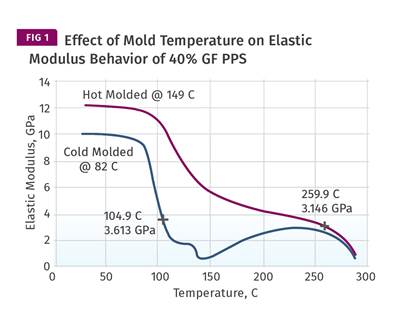A Processor's Most Important Job, Part 7: Reviewing Crystallinity
There are several process-related issues that influence crystallinity besides cooling rate. Let’s examine a few.
This is part seven of an eleven-part series focused on the most important job of a processor. To read the rest of this series, click these links:
part one, part two, part three, part four, part five, part six, part eight, part nine, part ten, part eleven.
We have spent a lot of time on the subject of crystallinity and there is a lot more that we could say. The emphasis of this discussion has been on cooling rate since it is within the control of the processor. But there are other factors that can influence crystallinity.
The process-related items on the list play a relatively minor role compared with cooling rate, but they should be understood to appreciate the big picture. The other factors are related to aspects of mold design and to the material itself.
Process Conditions
One process parameter that has a minor but measurable influence on crystallization is the melt temperature of the polymer as it enters the mold. The higher the temperature of the material, the longer it will take to cool to the point where crystallization stops. It is important to understand that we are referring to actual melt temperature, not the barrel settings. Anything that can alter the energy content in the polymer, such as screw rotation speed or back pressure, can also affect the rate of cooling and therefore the degree of crystallinity.
The other process condition that has an unexpected effect on crystallization is the pack and hold pressure profile. Higher pressures compress the material to a greater degree, forcing the polymer chains closer together and restricting their mobility. Since crystallization depends upon mobility, higher degrees of packing discourage crystallization.
This effect can be observed in a pressure-volume-temperature (PVT) diagram as shown in the accompanying graph. This shows the change in the specific volume of a PP as it cools while under different pressures. Larger changes in volume correspond in part to the achievement of a greater degree of crystallinity. It is apparent that this change in volume becomes smaller as the applied pressure increases. Both the melt temperature and the pack and hold pressure profile have a relatively small effect on crystallinity compared with cooling rate, but they are measurable, and they have been confirmed in laboratory tests.
Another interesting influence is orientation. This is a phenomenon that occurs whenever a polymer flows. The act of moving the polymer produces an uncoiling of the entangled chains; and the straighter chains, aligned closely together, can produce zones of higher crystallinity.
Thermoformers that produce parts in PET are quite familiar with this phenomenon and have learned that PET in a sidewall of a deep-draw container will exhibit a higher degree of crystallinity than the bottom of the container where the sheet did not stretch. This can affect the properties of the container. Too much crystallinity will reduce the toughness of the material and can result in brittle failures.
In injection molding, this type of crystallization is most often observed as a function of gate location and part geometry and is especially important in materials that can crystallize over an extended period of time, such as PE and PP.
Material Modifications
Other factors are related to the nature of the material that has been selected. This is frequently beyond the control of the processor. However, a processor who knows the role of material selection in the achievement of crystallization can offer its customer a way out of a thorny problem. Nucleation is one modification of material composition that influences the way a material crystallizes. This is often achieved through additives and is commonly used in PPs, nylons and polyesters.
Nucleation allows crystallization to begin at more sites simultaneously, producing a larger number of small crystals as opposed to a smaller number of large ones. This will alter the properties of the material, increasing stiffness while typically reducing impact resistance. It will also reduce the amount of shrinkage that the material exhibits as it cools, and it allows for a reduction in cycle time since the crystallization process begins and ends at higher temperatures. While nucleation is often accomplished intentionally with additives, it also can occur unintentionally with the addition of certain fillers and colorants.
Another material property that influences the rate of crystallization is molecular weight (MW). This is an often-forgotten relationship. Higher-MW grades of a given polymer will crystallize more slowly than their lower-MW counterparts. Again, if it is understood that crystallization is promoted by chain mobility, this makes perfect sense. In higher-MW systems, chain entanglement occurs to a greater degree and this limits mobility, suppressing the tendency for the material to form crystals.
Too much crystallinity will reduce the toughness of the material and can result in brittle failures.
We used this principle many years ago to solve a difficult problem with voids that formed in the thick section of a part molded from a glass-fiber-reinforced PBT polyester. The part had been designed with a nominal wall thickness of 3/16" but had an area approximately 3" from the gate where the wall thickness increased to almost 1".
This area was prone to form voids as the part cooled, a defect that was completely unacceptable to the end user. Process development had minimized the problem, however, quality checks still involved cutting open the thick section in almost 5 percent of our production to inspect for voids, since non-destructive imaging techniques were not readily available at that time. And even with all the appropriate process strategies in place, we struggled with certain lots of material.
When we analyzed our quality data as a function of lot-to-lot behavior, we noticed that the problem lots were the ones manufactured to the high end of the melt-flow-rate range. The nominal MFR specification was 11 grams per 10 minutes with a low end of 9 and a high end of 13.
Lots that came in below 11.5 grams per 10 minutes afforded us the needed processing window without producing voids. Voids occur due to excessive, localized shrinkage; and when the crystallization rate was faster this shrinkage occurred to a greater degree. The higher-viscosity lots shrank less.
We may have been the first processor to ever contact a material supplier and ask for a material that did not flow as well. The technical service representative for the resin company even tried to dissuade us from going in this direction, arguing that we needed an easier-flowing material so that we could pack more effectively. But the experimental data confirmed our approach and by cherry-picking lots of higher viscosity, we essentially eliminated the defect. We used this approach many times to solve internal void issues in thick walls.
We have probably exhausted the crystallinity conversation at this point. Next time we will delve into another defect that can be difficult to detect but is often driven by molding conditions: internal stress.
About the Author
Michael Sepe
Michael Sepe is an independent, global materials and processing consultant whose company, Michael P. Sepe LLC, is based in Sedona, Arizona. He has more than 40 years of experience in the plastics industry and assists clients with material selection, designing for manufacturability, process optimization, troubleshooting and failure analysis. Contact: 928-203-0408 • mike@thematerialanalyst.com.
Related Content
Back to Basics on Mold Venting (Part 2: Shape, Dimensions, Details)
Here’s how to get the most out of your stationary mold vents.
Read MoreThe Effects of Stress on Polymers
Previously we have discussed the effects of temperature and time on the long-term behavior of polymers. Now let's take a look at stress.
Read MoreThe Importance of Barrel Heat and Melt Temperature
Barrel temperature may impact melting in the case of very small extruders running very slowly. Otherwise, melting is mainly the result of shear heating of the polymer.
Read MoreA Systematic Approach to Process Development
The path to a no-baby-sitting injection molding process is paved with data and can be found by following certain steps.
Read MoreRead Next
A Processor’s Most Important Job, Part 8: Molded-In Stress
How processing adjustments can control molded-in stress.
Read MoreA Processor's Most Important Job, Part 6: Long-Term Effects
The importance of mold temperature to the development of the desired polymer crystalline structure becomes absolutely crucial in the case of high-performance materials.
Read MoreFor PLASTICS' CEO Seaholm, NPE to Shine Light on Sustainability Successes
With advocacy, communication and sustainability as three main pillars, Seaholm leads a trade association to NPE that ‘is more active today than we have ever been.’
Read More
.jpg;width=70;height=70;mode=crop)





















